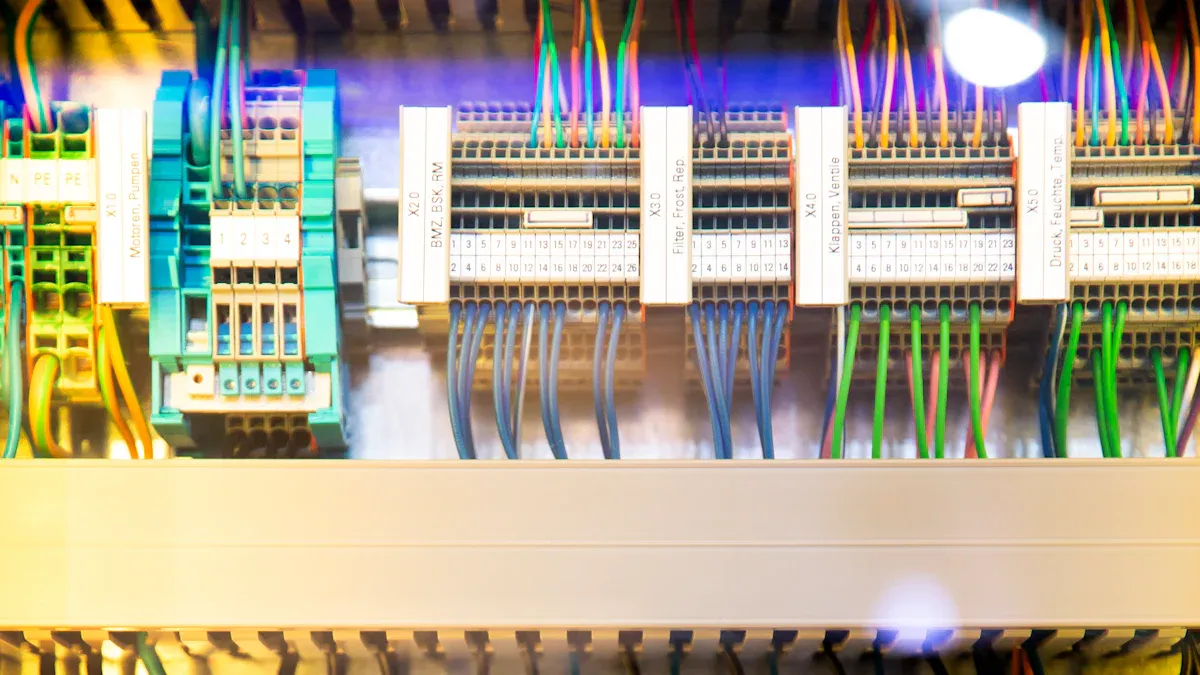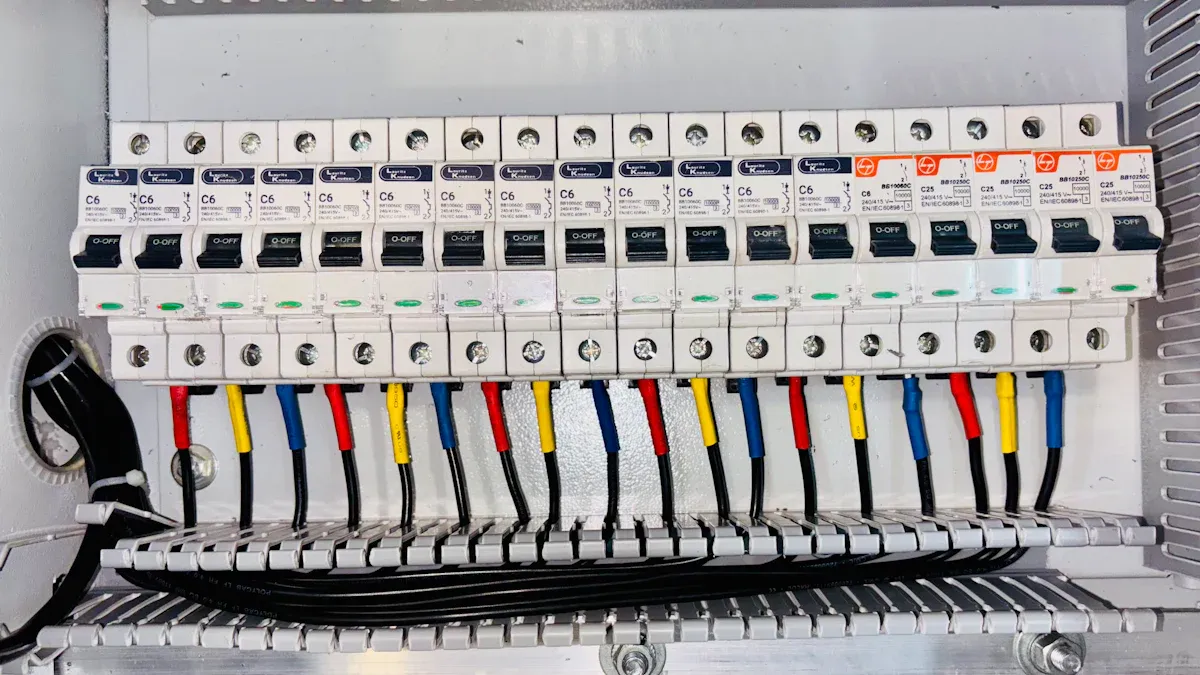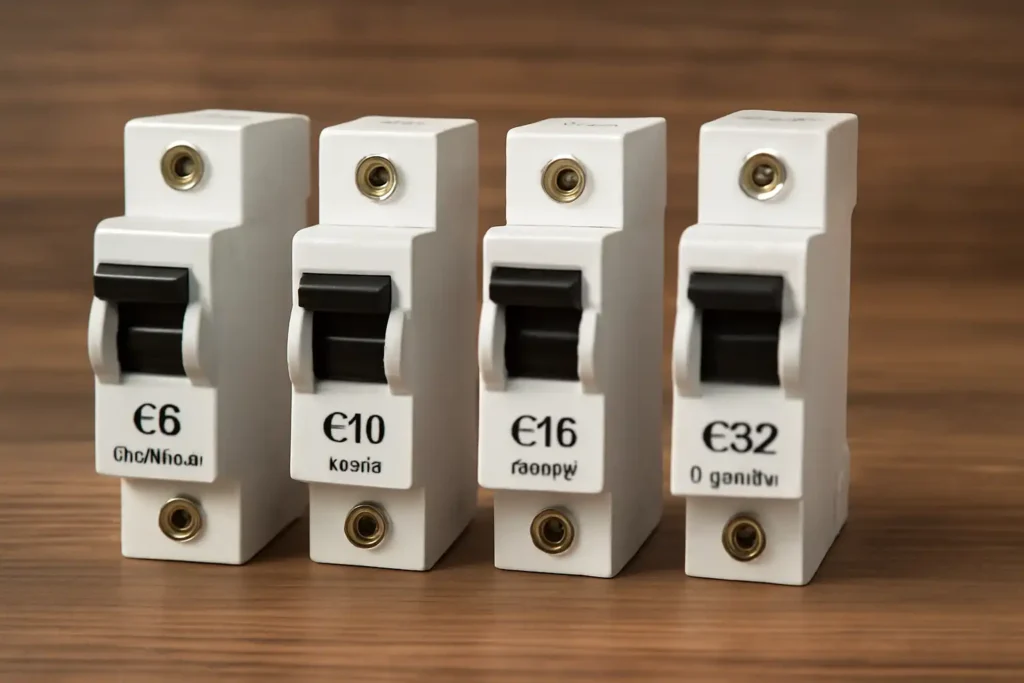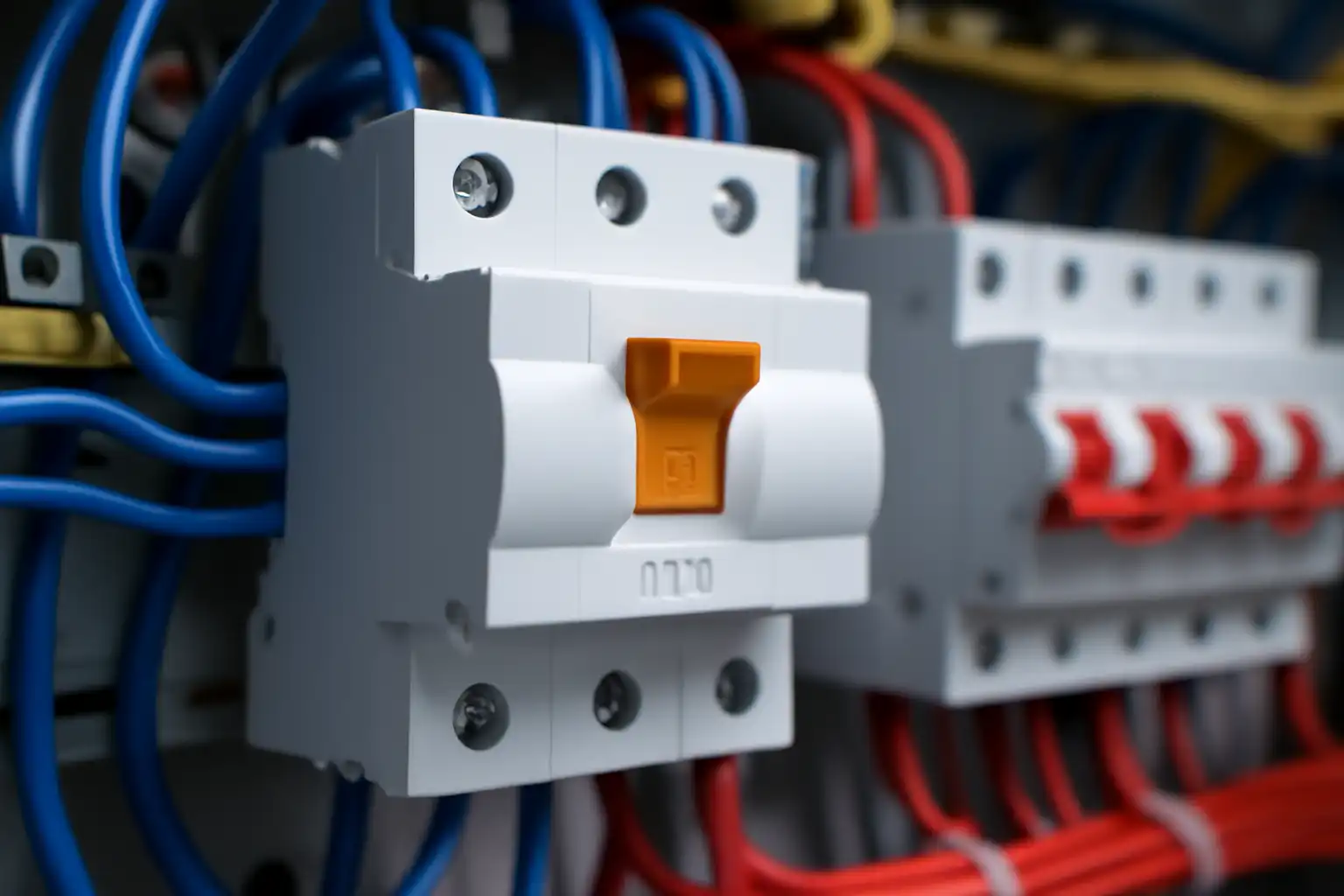To determine the capacity of a circuit breaker, begin by calculating the total electrical load in amps for the circuit. Then, include a safety margin of 25% to ensure the circuit breaker operates safely and efficiently. Use the following formula:
Capacity of circuit breaker = Load in Amps x 1.25
This approach prevents overheating and complies with electrical regulations. Accurate measurements of the capacity of a circuit breaker help maintain system safety and reduce risks such as overloads or fires. Always verify the load and apply the appropriate safety margin.
Key Takeaways
-
Add up the power of all devices to find the total amps.
-
Include 25% extra to avoid overheating and keep it safe.
-
Use this formula: Breaker size = Total amps x 1.25.
-
Make sure the breaker fits the circuit’s voltage and type.
-
Follow local rules to stay safe and avoid problems.
Understanding the capacity of a circuit breaker
What is circuit breaker capacity?
Circuit breaker capacity is the highest load it can handle safely. It is measured in amps and stops electricity flow during overloads. Manufacturers test breakers to set their capacity limits. These tests include checking the maximum short-circuit current and rated current. The rated current is the most electricity a breaker can carry nonstop. Standards like IEC 60898-1 explain how this is determined.
|
Aspect |
Description |
|---|---|
|
Maximum Short-Circuit Current |
The highest current a breaker can stop during a short circuit. |
|
Rated Current |
The most current a breaker can handle nonstop, based on standards. |
|
Standards |
UL certifies ratings; ANSI and IEEE rules apply to power breakers. |
Knowing these ratings helps you pick the right breaker. This keeps your system safe and working well.
Why is it important to calculate circuit breaker capacity?
Figuring out breaker capacity is key for safety and reliability. A correctly sized breaker stops dangers like overheating or fires. It also helps your devices work better. A small breaker trips too often, causing problems. A big breaker might not trip when needed, leading to risks like fires.
Electrical problems cause about 13% of home fires, says NFPA.
By adding up the amps and choosing the right breaker, you protect your home. This also helps save energy and keeps appliances safe.
Risks of incorrect capacity calculation
Wrong calculations can cause big problems. A small breaker trips too much, damaging your system. A large breaker might not trip, letting heat build up. This heat can start fires by igniting nearby items.
-
Picking the wrong breaker can harm your appliances.
-
Overloaded circuits waste energy and work less efficiently.
-
In 2018, electrical fires caused about 51,000 incidents in the U.S.
-
Overloaded circuits can overheat and start fires, showing why proper sizing is crucial.
Correct calculations keep your system safe and efficient. They also help appliances last longer.
How to calculate circuit load and determine breaker capacity

Step 1: Find the total load in amps
To figure out the circuit load, list all devices on the circuit. Look at their labels or manuals to find power ratings, usually in watts. If the rating is in watts, change it to amps using this formula:
Amps = Watts ÷ Voltage
For example, if a device uses 600 watts on a 120-volt circuit:
Amps = 600 ÷ 120 = 5 Amps
Add up the amps of all devices to get the total load. Include all devices, even ones used rarely, to avoid mistakes.
Tip: Use a multimeter to check the current if no power rating is available.
Step 2: Add a safety margin (25% of the total load)
After finding the total amps, add a safety margin. This ensures the breaker can handle extra demand or surges. Electrical rules suggest adding 25% to the total load. This keeps the breaker from tripping too easily and prevents overheating.
To find the safety margin, multiply the total amps by 0.25. For example, if the load is 16 amps:
Safety Margin = 16 x 0.25 = 4 Amps
Add this margin to the total load. In this case:
Adjusted Load = 16 + 4 = 20 Amps
This adjusted load ensures the breaker works safely.
Step 3: Use the formula: Load in Amps x 1.25
Finally, calculate the breaker size using this formula:
Capacity of circuit breaker = Load in Amps x 1.25
Using the adjusted load, multiply it by 1.25. For example, if the adjusted load is 20 amps:
Capacity of circuit breaker = 20 x 1.25 = 25 Amps
Choose a 25-amp breaker in this case. If the result is between sizes, round up to the next standard size. For example, if the result is 22 amps, pick a 25-amp breaker.
Note: Make sure the breaker matches the circuit’s voltage and type (e.g., single-phase or three-phase). This ensures it works correctly and follows electrical rules.
By following these steps, you can find the right breaker size. This helps avoid overloads, keeps things safe, and ensures your system works well.
Step 4: Confirm the voltage and circuit type
After finding the adjusted load and breaker size, check if the breaker matches the circuit’s voltage and type. This step ensures it works properly and meets safety rules.
1. Identify the Circuit Voltage
Find out the voltage of your circuit. Most home circuits in the U.S. are 120 volts or 240 volts. Commercial circuits may use higher voltages, like 480 volts. Check the circuit panel or device labels to find the voltage.
-
Why it’s important: Breakers are made for specific voltages. Using the wrong one can cause problems or dangers. For example, a 120-volt breaker cannot protect a 240-volt circuit safely.
2. Know the Circuit Type
Figure out if the circuit is single-phase or three-phase. Homes usually have single-phase circuits, while businesses often use three-phase ones. The circuit type affects how you calculate load and pick a breaker.
-
Single-phase circuits: These have one live wire and one neutral wire. They are common in homes for basic appliances.
-
Three-phase circuits: These have three live wires and are used for powerful equipment. They need special breakers.
3. Match the Breaker to the Circuit
Once you know the voltage and type, check if the breaker fits. Look at the voltage and phase ratings on the breaker. For example, a breaker marked “240V, 1P” works for a 240-volt single-phase circuit.
Tip: If your calculation is between two breaker sizes, choose the larger one. This helps the breaker handle extra demand safely.
4. Follow Electrical Codes
Make sure your breaker choice follows local electrical codes. These rules cover breaker sizes, voltage ratings, and installation steps. Following them keeps your system safe and avoids legal trouble.
By confirming the voltage and circuit type, you ensure the breaker works well and protects your system. This step helps prevent overloads, damage, and safety hazards.
Factors affecting the capacity of circuit breaker
Voltage and type of circuit (e.g., single-phase, three-phase)
The voltage and circuit type are key to choosing a circuit breaker. Each circuit works at a set voltage, and the breaker must match it. For example, most home circuits use 120 volts. Bigger appliances or commercial circuits may need 240 volts or more. Use a multimeter to check the voltage for safety and accuracy.
The circuit type also affects the breaker’s capacity. Single-phase circuits, common in homes, handle small loads like lights and appliances. Three-phase circuits, used in businesses, manage larger loads and need special breakers. These breakers are built to handle higher power levels.
Tip: Look at the breaker’s nameplate for voltage and phase details. This ensures the breaker fits the circuit and works properly.
Environmental conditions (e.g., temperature, humidity)
Conditions like temperature and humidity can change how a breaker works. Breakers are made to work within certain temperature limits. Extreme heat might make them trip too soon. Cold weather could delay their response, which is unsafe.
Humidity is another issue. Too much moisture can cause rust or short circuits. This lowers the breaker’s efficiency and lifespan. Manufacturers test breakers in different conditions to ensure they work well in all climates.
|
Description |
|
|---|---|
|
High and low temperatures |
Ensures the breaker works in extreme temperatures. |
|
Humidity |
Tests performance in wet or damp environments. |
When picking a breaker, think about where it will be used. For harsh conditions, choose a breaker rated for those environments. This keeps the system safe and reliable.
Compliance with electrical codes and standards
Following electrical codes is important for safety and proper system function. These rules help prevent overloads, fires, and damage. For example, the National Electrical Code (NEC) gives rules for sizing wires and calculating loads. Sections like NEC 210.19(A) and NEC 220.14 explain branch circuit requirements and load calculations.
|
Code/Standard |
Reference |
Description |
|---|---|---|
|
NEC |
210.19(A) |
Wires for branch circuits must match the load. |
|
NEC |
210.21 |
Explains branch circuit rules. |
|
NEC |
220.14 |
Details load calculations for circuits. |
|
IEC |
N/A |
International rules for electrical systems. |
|
IEEE |
N/A |
Safety guidelines for electrical equipment. |
Always follow local codes when choosing a breaker. This ensures your system is safe, efficient, and meets legal requirements.
Practical examples to calculate electrical load and breaker capacity

Example 1: Residential lighting circuit
To figure out the breaker size for home lighting:
-
Find the Load:
Add up the amps of all devices. For example:-
Refrigerator: 6A
-
Microwave: 10A
-
Lights: 4A
-
-
Check Voltage:
Assume the circuit uses 120 volts. -
Continuous Load:
If the fridge and microwave run nonstop, calculate:Continuous load = 16A x 1.25 = 20A -
Choose Wire Size:
NEC Table 310.16 says 12 AWG copper wire handles 20A at 60°C. -
Pick a Breaker:
Use a 20A breaker to match the wire and stay safe.
This example shows how to calculate load and pick the right breaker.
Example 2: Kitchen appliance circuit
Kitchen devices need their own circuits because they use more power. Here’s a guide for common appliances:
|
Appliance Type |
Circuit Requirement |
|---|---|
|
Electric Range/Oven |
Needs a 120/240-volt circuit |
|
Refrigerator |
|
|
Dishwasher |
Needs its own circuit |
For example, if a fridge uses 8A on a 120V circuit, add a safety margin:
Breaker capacity = 8A x 1.25 = 10A
Pick a 15A breaker, the next size above 10A. Always match the breaker to the appliance’s voltage and circuit type.
Example 3: Commercial three-phase circuit
Three-phase circuits power big machines in businesses. To find the breaker size:
-
Add the Load:
Add the amps of all machines. For example, three motors with 10A, 15A, and 20A equal 45A total. -
Add Safety Margin:
Multiply the total load by 1.25:Adjusted load = 45A x 1.25 = 56.25A -
Pick the Breaker:
Round up to the next size. Choose a 60A breaker. -
Check Voltage and Type:
Make sure the circuit uses the right voltage (e.g., 480V) and is three-phase. Use a breaker rated for these needs.
By following these steps, you can safely size breakers and meet code rules.
To figure out a circuit breaker’s capacity, follow three steps. First, add up the amps of all devices on the circuit. Then, include a 25% safety margin to handle extra power needs. Finally, check the circuit’s voltage and type to confirm your calculation.
Correct calculations keep your system safe from overloads and meet electrical rules. If you’re unsure or have a tricky setup, ask a licensed electrician for help. They make sure everything works safely and correctly. 🛠️
Tip: Safety should always come first with electrical work.
FAQ
What happens if I pick a breaker that’s too big?
A breaker that’s too big might not trip during overloads. This can cause wires to overheat or even start fires. Always choose a breaker that matches the circuit’s load and follow safety rules.
What tools do I need to find circuit load?
You’ll need a multimeter to check current, a calculator for math, and device manuals for power ratings. These tools help you figure out the total amps and make accurate calculations.
What is the usual safety margin for breakers?
The usual safety margin is 25% of the total load. This helps the breaker handle extra power without tripping too soon. Multiply the load by 1.25 to add this margin.
How are single-phase and three-phase circuits different?
Single-phase circuits have one live wire and are used in homes for small devices. Three-phase circuits have three live wires and power big machines in businesses. Each type needs specific breakers.
What if I don’t know the right breaker size?
If you’re unsure, ask a licensed electrician for help. They can check your circuit, calculate the load, and suggest the right breaker. This keeps things safe and follows electrical rules.
The following information may be of interest to you
How to choose the appropriate size of circuit breaker
How to Calculate the Load Capacity of a 32 Amp MCB
How to replace the circuit breaker correctly




